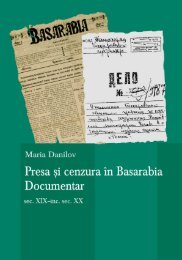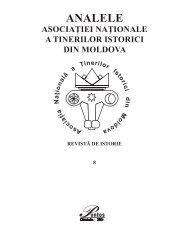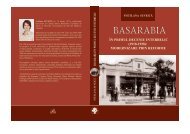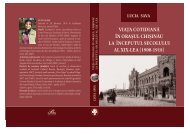Document PDF - Asociatia Tinerilor Istorici din Moldova
Document PDF - Asociatia Tinerilor Istorici din Moldova
Document PDF - Asociatia Tinerilor Istorici din Moldova
Sie wollen auch ein ePaper? Erhöhen Sie die Reichweite Ihrer Titel.
YUMPU macht aus Druck-PDFs automatisch weboptimierte ePaper, die Google liebt.
‘standard’ amount per year – given to both students in 1558, on May 26 th , that is, before the<br />
fi rst letter was written. 29 It cannot be established if some other kind of fi nancial support was<br />
afforded to them later on. It could be that another sum was granted to both students after the<br />
fi rst letter was written although there is no indication that this was the case. However, there is<br />
documented information that the town council of Košice became involved in the subsequent<br />
fate of these students, at least of one of them. There is a letter preserved in the town archives<br />
dated 1560, which states that Stephanus Mustricius was successfully working as school rector<br />
in Sobraniec, where he was sent by the town council of Košice to help establish a Protestant<br />
school. 30 Thus, it is most probable that both students stayed at the University of Wittenberg for<br />
two years, from 1557 to 1559, afterwards returning to the region and fi n<strong>din</strong>g employment with<br />
the help of the town council.<br />
Categories of benefi ciaries<br />
In addition to estimating the duration of fi nancial support, the question of who were the<br />
benefi ciaries deserves special attention. Several categories of benefi ciaries could be established<br />
from analyzing the sources. The fi rst category, representatives of which were most successful<br />
in receiving fi nancial support, especially for long periods of time, included members<br />
of well positioned families in the town. Among these, the case of Georgius Buntzler has been<br />
already mentioned. A second category of benefi ciaries, in some ways related to the fi rst one,<br />
was represented by children of town’s burghers or other former urban employees who held<br />
important functions in the town administration or at the local school. In this case, the fi nancial<br />
support accorded was of a general character and meant to help the young men in acquiring<br />
some education and then assist them in fi n<strong>din</strong>g a job either in Košice or elsewhere. Most of<br />
this help occurred after the death of the respective pupils’ father. Two such cases are well<br />
documented in the letters preserved in the town archives, namely those of the brothers Gulden<br />
and Kauffi n. 31<br />
It occurred sometimes that fi nancial support was accorded to clergy or school teachers<br />
already employed in the town in order to go to a university to improve their qualifi cations.<br />
These persons belong to the third category of town council benefi ciaries. Such is the case of<br />
Martinus Schacht, student at Wittenberg in 1563. Before going to Wittenberg, Schacht had<br />
been working at the local school in Košice as a teacher’s assistant. 32 He went to Wittenberg<br />
with the support of the town council in 1563 and sent three letters back home during this year. 33<br />
His fi rst letter is an expression of gratitude addressed to the town notary, Leonard Kromer, for<br />
his support supplemented by three songs he hoped the addressee will enjoy (unfortunately<br />
lost). The second letter was addressed to the town council of Košice, presented in June 1563,<br />
and represented a rhetorical and fl orid acknowledgment of the town administration’s merits<br />
in the propagation and support of the studies of its citizens. The third letter was sent in September<br />
of the same year. In it the author implored the council to be sent some help in order to<br />
survive the winter successfully and to return in order to be again of use for the town.<br />
A copy of a letter of response from the town council to Martinus Schacht is preserved in<br />
the town archives. In this letter, the town council confi rms the sen<strong>din</strong>g of money and expresses<br />
their hopes that, one day, Martinus Schacht will return home to take a job either at the church<br />
29<br />
AMK H III/2, mac. 8, folio 54v: Eodem die duobus adolescentibus Stephano Thehani et alteri Stephano Mustricz<br />
auxilium ad studia Vitebergam fl . 50.<br />
30<br />
AMK H I, no. 2249/60. See also VARSÍK 1991, 129-148, here 130.<br />
31<br />
AMK H I, no. 2301/98; no. 2392/44; no. 2392/26; no. 3473/105; no. 3526/64; and no. 3589/27.<br />
32<br />
See a letter sent by Adamus, minister ecclesiae Barphensis in 1558 to ”doctor et humano juveni Martino<br />
Schochot, collaboratori in schola Casschoviensi“ […] edited by Lajos Kemény: KEMÉNY 1891, 81-83.<br />
33<br />
AMK H I, no. 2446/140; no. 2446/134; and no. 2446/135.<br />
– 210 –
















